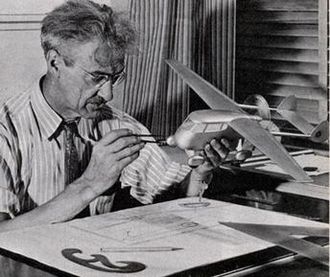William Bushnell Stout

William Bushnell Stout (March 16, 1880 – March 20, 1956) was a pioneering[1][2] American inventor, engineer, developer and designer whose works in the automotive and aviation fields were groundbreaking.[3][4][5][6] Known by the nickname “Bill”, Stout designed an aircraft that eventually became the Ford Trimotor and was an executive at the Ford Motor Company.[1][7]
William Bushnell “Bill” Stout was born March 16, 1880 in Quincy, Illinois. He graduated from the Mechanic Arts High School, in St. Paul, Minnesota in 1898. He then attended Hamline University, and transferred in his second year to the University of Minnesota, being forced to quit due to extreme eye problems. He married Alma Raymond in 1906. Stout was interested in mechanics, especially aeronautics, founding the Model Aero Club of Illinois. In 1907 he became Chief Engineer for the Schurmeir Motor Truck Company and in 1912, he became automobile and aviation editor for the Chicago Tribune. In the same year he founded Aerial Age, the first aviation magazine ever published in the United States. He was also a contributor to the Minneapolis Times under the pen name, “Jack Knieff.”[8]
In 1914, Stout became Chief Engineer of the Scripps-Booth Automobile Company. His “Cyclecar” had caught the attention of Alvan MacCauley who subsequently brought Stout to Packard Motors in Detroit. He had become General Sales Manager of the Packard Motor Car Company and in 1916, when they started an aviation division, they asked Stout to become its first Chief Engineer. In 1919 he started the Stout Engineering Company in Dearborn, Michigan, complete with a research section and later built the prototype Stout Scarab car in 1932. In 1934 he founded the Stout Motor Car Company.[9] The “beetle-like” Scarab featured an all-aluminum tubular airframe covered with aluminum skin, with the engine compartment at the rear, a sealed storage compartment in front of a passenger compartment with reclining aircraft-type seats. The front or nose of the vehicle contained the spare tire. Only nine Scarabs were ever built and although advanced, the public never appreciated the innovative features of the vehicles.
In the mid-1930s, Stout, in co-operation with L.B. Kalb of Continental Motors, a major manufacture of lightweight air cooled aircraft engines, and did some extensive research and pre-production development into rear engine drive automobiles which were powered by aircraft engines. Stout even commissioned the well known Dutch auto designer John Tjaarda to design some streamlined car bodies, although none of the car designs ever reached production.[10]
In the last years of World War II, Stout, in co-operation with Owen-Corning, began what was called Project Y to build a one-off car for evaluation of ideas like a frame-less fiberglass body, belt drive rear wheel drive, a suspension which kept the vehicle from leaning into turns by adjusting the suspension using compressed air, and push button electric doors. When the vehicle was made public in 1946, Stout picked the name Forty-Six for that year. Some firms considered producing the Forty-Six, but as Stout stated he doubted there would be much of a market for a $10,000 dollar car, the estimated price if it had been mass-produced.[11]
